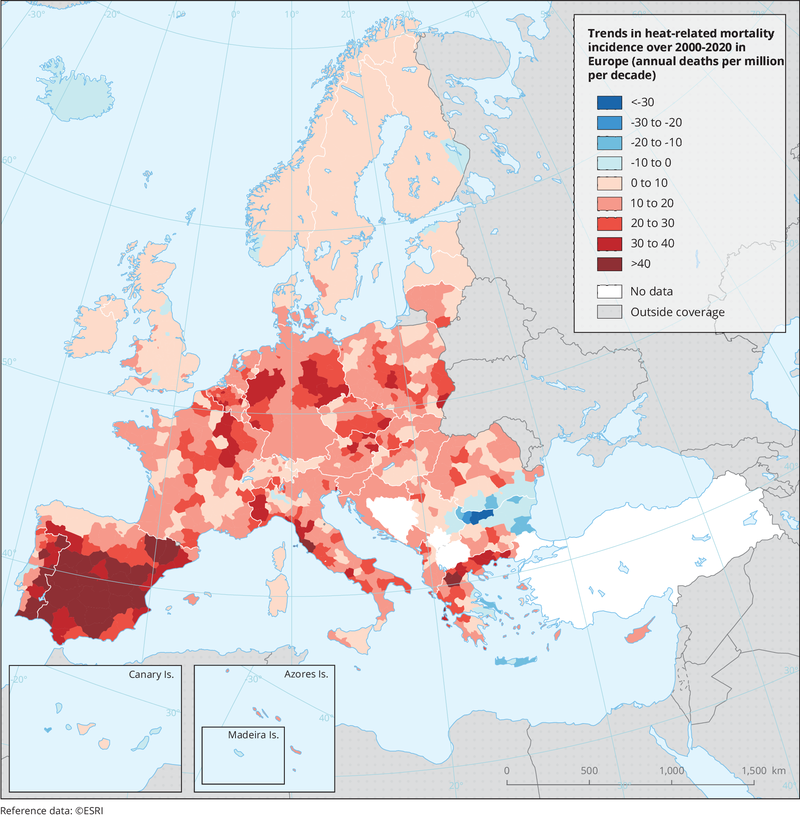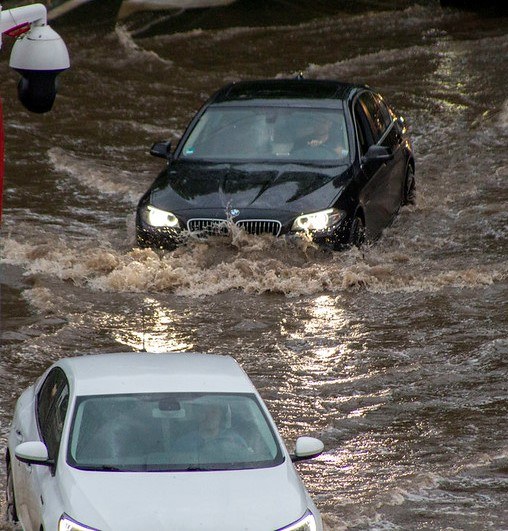All official European Union website addresses are in the europa.eu domain.
See all EU institutions and bodiesHeatwaves, droughts, wildfires and floods in a changing climate are increasingly affecting our health and well-being. The EU is boosting climate mitigation and adaptation actions at national, city and municipality levels. Will these measures help us withstand weather extremes in the future?
This past winter was exceptionally warm and last summer saw climate records being broken across many parts of Europe. Many regions endured long and intense heatwaves, with temperatures soaring over 40 degrees Celsius. Average summer temperatures in Europe were the highest on record.
Heatwaves are the greatest, direct, climate-related health threat to Europe’s population. Flooding, wildfires, storms and climate-sensitive infectious diseases are also major threats to our health and well-being. The situation will only get worse unless enough climate change adaptation and mitigation measures are taken.
Climate change is affecting the health of the most vulnerable
The elderly, children, low-income groups and people with health problems or disabilities are the most affected by climate change, according to a recent EEA study. The distribution of environmental threats and the impacts they have on our health closely mirror differences in income, unemployment and education levels, according to a 2019 EEA report.
Climate change, in combination with an ageing population and growing urbanisation across Europe, means that many vulnerable people will be exposed to high temperatures. This is particularly the case in southern and central Europe. These groups will be further exposed because many schools and hospitals are located in areas experiencing the urban heat island effect.
High temperatures can cause heat stress, which increases the risk of death from heat exhaustion and heatstroke. This also leads to other indirect health impacts, including poorer mental health. Overall, heatwaves are estimated to have caused around 90% of deaths from weather- and climate-related extreme events in Europe over the past four decades.
Climate change also brings more flooding. Flood-prone areas in some countries tend to have higher shares of elderly and unemployed people living there. These people may not be able to relocate or pay for insurance or adequate flood protection for their homes, according to an EEA analysis. Moreover, an emerging threat is the climate-related likelihood of various infectious diseases in Europe. Diseases like dengue and West Nile fever are expanding to previously unaffected areas of Europe.
Map 1. Trends in heat-related mortality incidence over 2000-2020 in Europe

Note: Epidemiological models were combined with with weekly temperature and mortality data to estimate the number of heat-related deathsover the period 2000-2020. A linear trend was fitted to the yearly time series of heat-related mortality incidence, whose slope representsthe indicator expressed as annual deaths per million inhabitants per decade. The smallest regions possible were used, depending on thespatial resolution of the mortality data in a given country, ranging from NUTS (3) to countries. Data were not available for Türkiye, Bosniaand Herzegovina, Kosovo (under UN Security Council Resolution 1244/99) and North Macedonia.
Sources: van Daalen et al. (2022)
Adaptation and mitigation are crucial for lowering health risks
The health risks posed by heatwaves will increase unless more climate change adaptation and mitigation measures are taken. For example, setting up public alert systems, raising awareness, putting in place ready-to-go actions at health and social care centres, urban greening, better building design and adjusting working times can all help protect people, according to our EEA report.
But adaptation measures rarely benefit everyone the same way. Making sure that the most vulnerable groups are not left behind requires that these actions benefit those groups specifically. For example, green spaces can be added to areas that need them most. Equitable adaptation also needs vulnerable groups to have a voice in the process. The health benefits of urban green spaces are well recognised, especially for children and the elderly.
EU action on climate and health in practice
The EU has put in place a range of laws, policies and measures to promote adaptation. These help guide national, regional and local authorities to build resilience and readiness to respond and protect human health.
Key to this is the European Climate Law, which makes adaptation a legal obligation. Moreover, the European Green Deal furthers adaptation, aiming to protect the health and well-being of citizens from environment-related risks and impacts. This is complemented by the EU strategy on adaptation to climate change, which sets out how the EU can adapt to the unavoidable impacts of climate change and become climate resilient by 2050.
The strategy includes boosting data use through the EU's adaptation knowledge hub Climate Adapt. It also includes efforts to speed up actions and ensure that adaptation measures are taken up by all levels of government. Plus, the European Climate and Health Observatory has been set up to provide authorities easy access to resources that can help them anticipate and minimise health threats caused by climate change.
Currently, all EU Member States have national adaptation policies in place. More than 300 European regions and local authorities are participating in the EU Mission on adaptation to build resilience against the impacts of climate change.
Climate change and health in a nutshell
- Climate change and related consequences such as heatwaves, floods and the spread of infectious diseases affect people’s health in many ways. The most vulnerable groups are often the most affected.
- Protecting human health from the impacts of climate change is recognised in the EU’s Climate Law. National and local authorities are working on building societal resilience against the effects of climate change.
- More action is needed at all levels of government across Europe to protect the elderly, children, low-income groups and people with health problems or disabilities who are the most affected by climate change.

What can I do?
- Find out what your local, regional and national authorities are doing to invest in urban greening, climate-proof public buildings, drinking water fountains and other adaptation measures.
- Follow the national or local government guides for protecting yourself, family members and those in your community during heatwaves or other extreme weather events.
- Consider what you can do to reduce your carbon footprint. The European Climate Pact is an opportunity to participate in climate action across Europe.
This feature article is part of EEA Signals 2023 — Environment and health in Europe.
See other articles in EEA Signals 2023
- Editorial — Caring for the environment is caring for ourselves
- Europe’s air is getting cleaner and improving people’s health
- Water quality and quantity are key for well-being
- Are you noticing the harmful noise around you?
- Safe and sustainable chemicals
- Interview — What is the European environment and health atlas?
- Interview — Investing in safer chemicals









